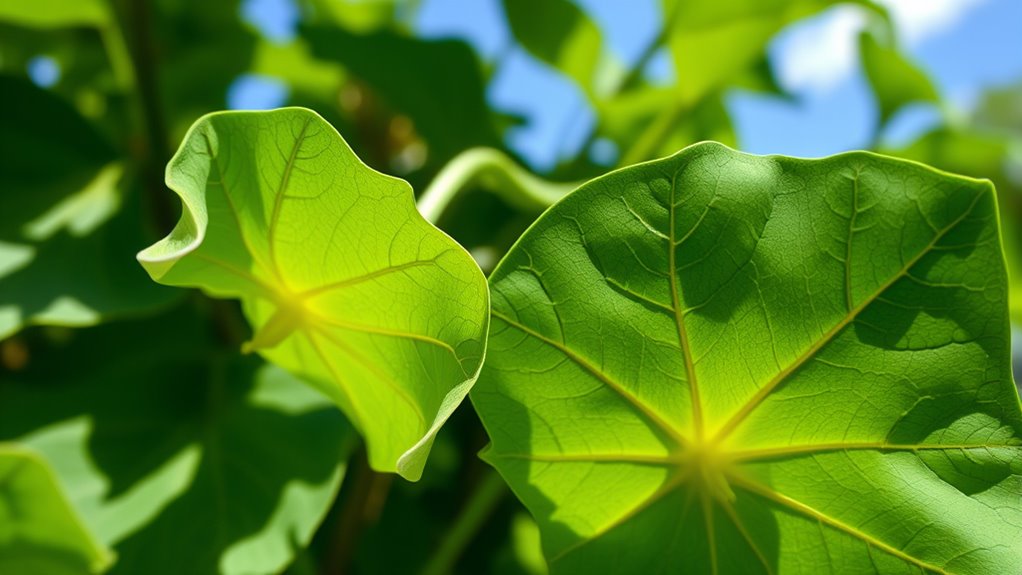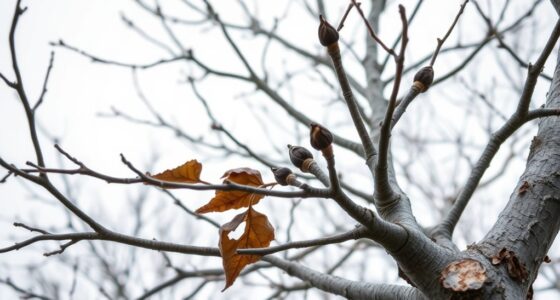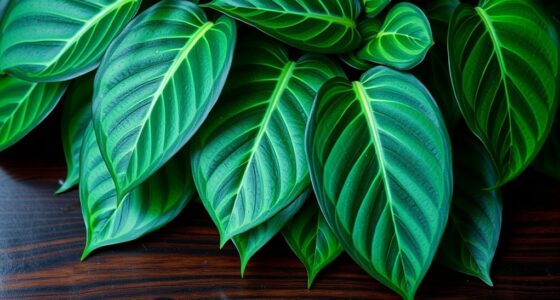Morning glory leaves often droop during the day as a natural resting response, especially when they heat up and lose water through transpiration. However, if drooping happens suddenly, persists despite watering, or leaves turn yellow or brown, it could be a sign of water stress or other issues. Proper watering, good drainage, and monitoring environmental conditions help keep your plants healthy. If you want to understand how to tell the difference and keep your garden thriving, continue exploring these tips.
Key Takeaways
- Morning glories naturally droop during the hottest part of the day as a resting behavior and typically rebound in the evening.
- Persistent drooping, discoloration, or limp leaves despite proper watering may indicate water stress or other health issues.
- Check soil moisture; dry soil often causes leaves to wilt, signaling the need for deep, regular watering.
- Ensure the plant has adequate drainage and is grown in well-draining soil to prevent root rot and water deficiency symptoms.
- Observe environmental conditions like high temperatures or low humidity, which can increase water loss and cause drooping.
Understanding the Natural Behavior of Morning Glories
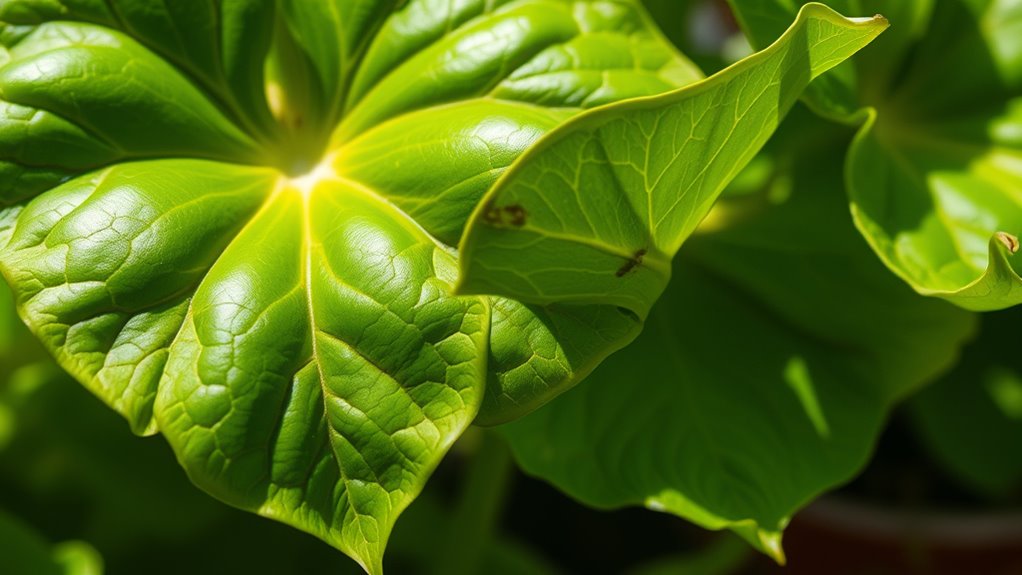
Morning glories are known for their vibrant, trumpet-shaped flowers and fast-growing vines, which open in the morning and close by late afternoon. Their flower color varies from deep blue and purple to pink and white, adding beauty to any garden. Understanding their natural behavior helps you recognize when drooping leaves are normal or a sign of trouble. During seed germination, these plants often display rapid growth and vibrant blooms, indicating healthy development. As the seedlings emerge, they tend to stretch toward the sun, which can cause some leaf drooping initially. This is typical and not a cause for alarm, especially since their flowering cycle involves opening in the morning, which is a natural part of their flowering pattern. Knowing that their flowering cycle involves opening in the morning helps you anticipate their behavior and appreciate their natural rhythm without unnecessary concern. Additionally, understanding the importance of plant growth stages can help you better care for your morning glories throughout their lifecycle.
Identifying Signs of Water Deficiency
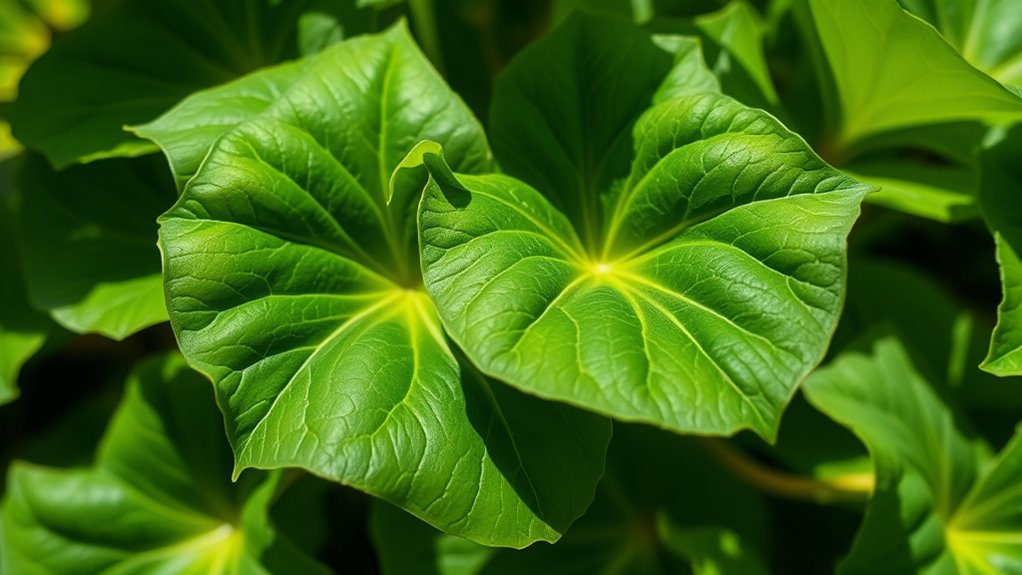
When your morning glories start showing signs of water deficiency, their leaves often become wilted or droopy, even during the early part of the day. You might notice leaf yellowing, which signals stress from insufficient water. Over time, prolonged dryness can lead to root rot, weakening the plant’s ability to absorb moisture and nutrients. Check the soil moisture regularly—if it feels dry well below the surface, your plant isn’t getting enough water. Wilting leaves that don’t recover after watering are a clear sign, especially paired with yellowing. Be cautious of overwatering, which can cause root rot, but under-watering is the more common cause of drooping and yellow leaves. Identifying these signs early helps you adjust watering habits before serious damage occurs.
How Environmental Conditions Affect Leaf Turgidity
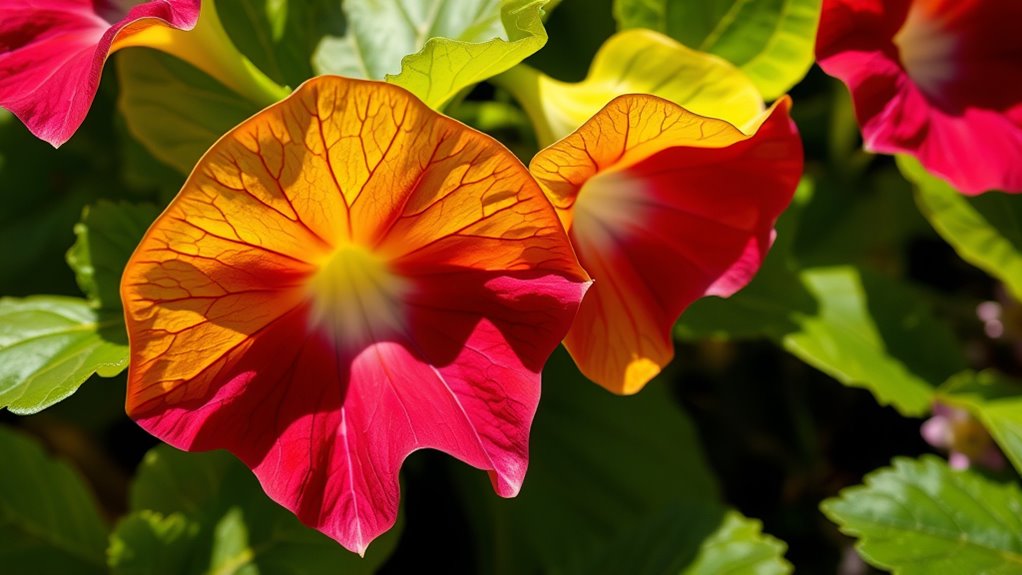
Environmental conditions play a crucial role in maintaining leaf turgidity, which is the pressure of water inside the cells that keeps leaves firm and healthy. When soil moisture is high, your plants absorb water easily, helping leaves stay rigid. Conversely, dry soil reduces water uptake, causing leaves to droop. Air humidity also impacts turgidity; low humidity speeds up water loss through transpiration, leading to wilting. Regularly monitoring soil moisture levels can help prevent stress and maintain healthy, firm leaves. Understanding the optimal angles for pinball machines can also influence how plants respond to light and airflow in indoor environments, indirectly affecting their hydration. High air humidity reduces water loss, while low humidity accelerates dehydration. Consistent watering maintains turgidity.
Differentiating Between Resting and Stress Responses
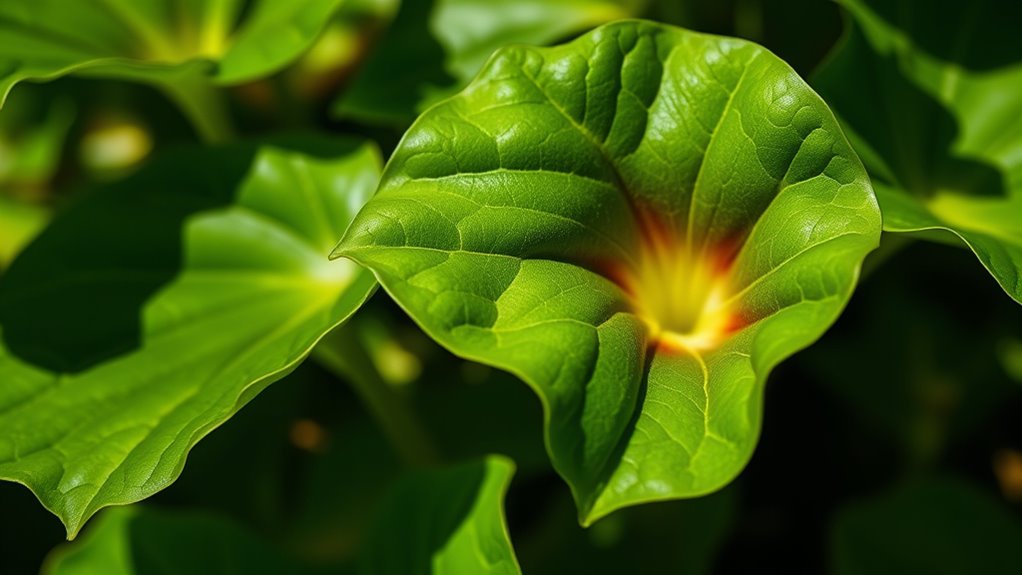
Drooping leaves can signal either a plant’s natural resting phase or a response to stress. To tell the difference, observe your morning glory closely. Resting leaves often droop during the hottest part of the day and rebound in the evening, showing no other signs of distress. Stress-related drooping usually occurs suddenly, with leaves appearing limp and discolored. To address potential stress, consider pruning strategies to improve airflow and remove damaged foliage. Additionally, soil amendments like organic compost can enhance soil health and water retention, reducing stress caused by poor soil conditions. Monitoring your plant’s response after these adjustments helps determine whether drooping is part of its natural cycle or a stress response needing further action. Recognizing these signs ensures your morning glory stays healthy and vibrant.
Proper Watering Techniques for Healthy Growth
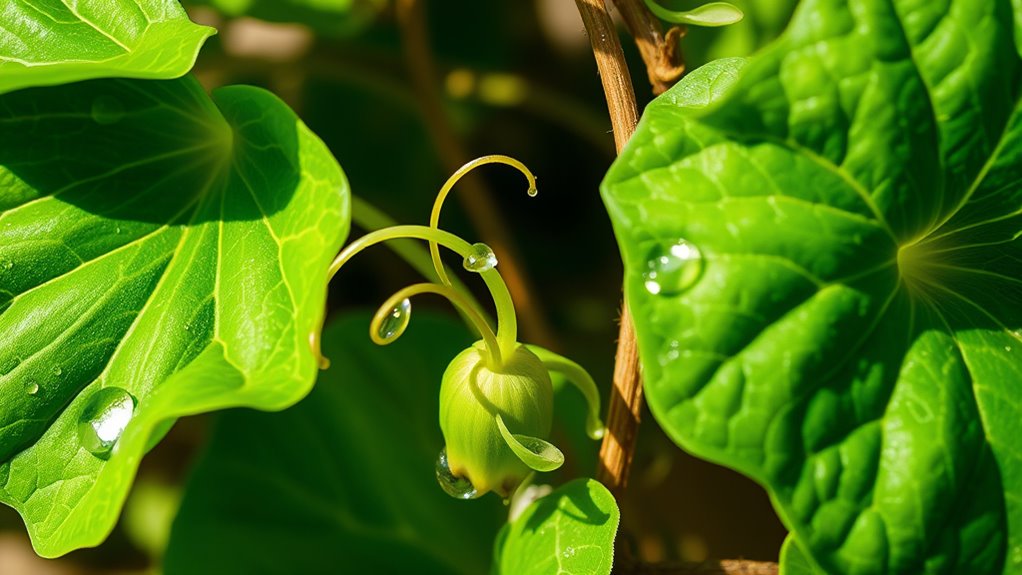
To keep your morning glories healthy, you need to water them at the right frequency—usually when the top inch of soil feels dry. It’s best to water early in the morning or late in the afternoon to prevent evaporation and guarantee absorption. Make sure your planting area has proper drainage to avoid waterlogged roots that can cause drooping leaves. Regular watering can also help prevent water stress, which may lead to drooping or wilting. Ensuring proper soil drainage is essential, as poor drainage can contribute to root issues and plant stress. Maintaining good indoor air quality through proper watering and cleaning can support overall plant health and growth.
Watering Frequency Tips
Ensuring your morning glory leaves stay vibrant and healthy depends largely on getting the watering schedule right. Water consistently, but avoid overwatering, which can lead to root rot. Check the soil moisture regularly—water when the top inch feels dry. Deep watering encourages strong roots and supports healthy growth. Remember, proper fertilizer application enhances overall health, making plants more resilient to pests. Maintain good pest management to prevent damage that can stress your plant further. Additionally, understanding your plant’s water needs is essential; proper watering techniques help prevent issues like leaf drooping and promote vigorous growth. Using techniques like soil moisture monitoring can further optimize watering practices for your plants’ well-being. For optimal results, selecting the right watering tools can make a significant difference in maintaining consistent moisture levels.
Optimal Watering Times
Timing your watering sessions correctly can substantially boost your morning glory’s health. Water in the early morning or late afternoon when temperatures are cooler, reducing evaporation and ensuring roots absorb moisture effectively. Avoid watering during the heat of midday, which can cause rapid drying. Proper watering times support ideal fertilizer application, helping nutrients reach roots efficiently. Consistent moisture also encourages healthy pruning methods, promoting bushier growth and fewer drooping leaves. Remember, overwatering at the wrong times can lead to root rot, so monitor soil moisture carefully. Adjust your schedule based on weather conditions, ensuring your plant receives enough water without waterlogging the soil. Using proper watering techniques is essential for optimal plant health and growth. Proper timing enhances overall plant vigor and keeps your morning glory thriving throughout the season.
Proper Drainage Methods
Proper drainage is essential for maintaining healthy morning glories, as it prevents water from pooling around the roots and causing rot. To achieve this, focus on improving soil aeration and ensuring excess water flows away quickly. You can do this by:
- Incorporating organic matter like compost to enhance soil structure
- Using well-draining soil mixes designed for flowering plants
- Elevating planting beds slightly to promote runoff
- Avoiding overwatering, which can suffocate roots
- Regularly checking drainage holes in containers for blockages
- Incorporating natural materials such as wood, stone, and linen can also help improve drainage and support plant health. Ensuring proper drainage also minimizes the risk of water-related cybersecurity vulnerabilities, which can compromise plant health if neglected. These steps support root health by preventing waterlogged soil and promoting oxygen flow to the roots. Proper drainage helps morning glories thrive, avoiding drooping caused by excess moisture or root rot. With good drainage, your plants will grow stronger and stay vibrant. Additionally, selecting appropriate soil conditions tailored for flowering plants can further enhance drainage efficiency and plant vitality.
Additional Care Tips to Prevent Leaf Wilting
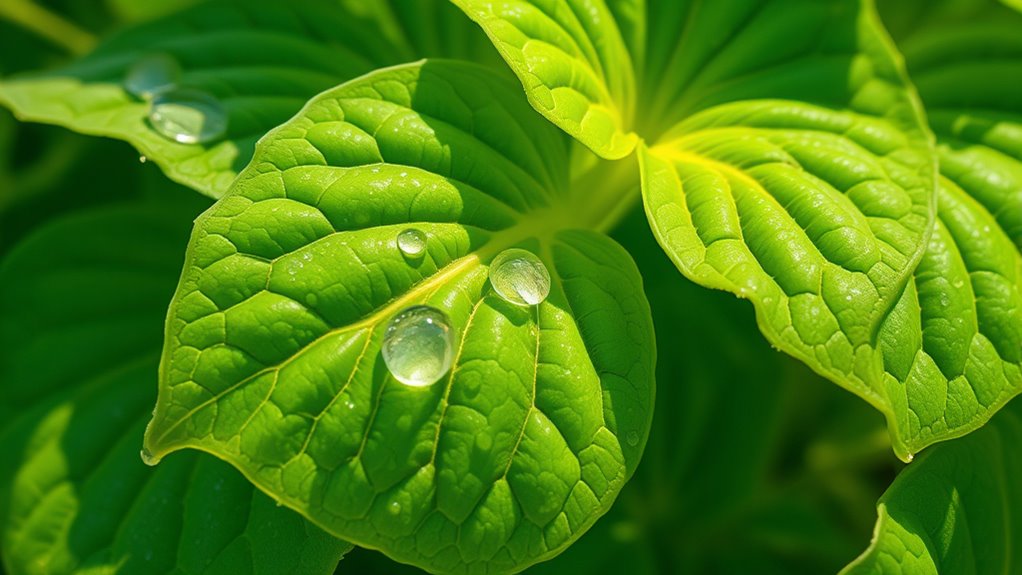
To keep your morning glories healthy and prevent leaf wilting, focus on maintaining proper watering techniques and ensuring ideal growing conditions. Consistently water them at the right times and depths, and provide enough sunlight and airflow. These simple adjustments can make a big difference in keeping your plants vibrant and strong. Additionally, monitoring for plant stress caused by environmental factors can help prevent issues before they arise. Being aware of signs such as drooping leaves can indicate watering needs or environmental stress, enabling prompt corrective actions. Incorporating knowledge of Plants – Soul Sanctuaries can also guide you in selecting the best environment and care routines specific to your plants.
Proper Watering Techniques
Ensuring your morning glory receives the right amount of water is key to preventing drooping leaves. Proper watering involves more than just pouring water; it’s about maintaining soil health and plant vitality. Water deeply and consistently, allowing moisture to reach the roots. Use a watering schedule that fits your climate, avoiding overwatering which can suffocate roots. Incorporate soil aeration by loosening the soil to improve drainage and oxygen flow. Balance your fertilizer use to prevent excess salts that hinder water absorption. Check soil moisture regularly with your finger to avoid both drought and waterlogging. Remember, healthy roots and soil promote steady hydration, keeping your morning glory vibrant and resilient. Consistent watering helps prevent stress-induced drooping and supports overall plant health. Additionally, understanding how AI-powered devices can monitor soil moisture levels can optimize your watering routine for better plant care. Maintaining proper watering techniques is crucial for preventing leaf wilting and ensuring your plant thrives.
Optimal Growing Conditions
Achieving ideal growing conditions is essential for preventing your morning glory leaves from wilting. Guarantee your soil has the right acidity, preferably slightly acidic with a pH between 6.0 and 7.0, to promote healthy nutrient uptake and vibrant leaf coloration. Soil that’s too alkaline can cause deficiencies, leading to dull or pale leaves and increased vulnerability to stress. Additionally, provide well-draining soil to prevent waterlogging, which can weaken roots and cause wilting. Maintain consistent watering without overdoing it, and place your plants where they’ll receive full sun. Healthy soil and proper light conditions foster robust growth, reducing the risk of leaf drooping caused by environmental stress. When your morning glories thrive, their leaves stay vibrant and resilient.
When to Seek Professional Advice or Additional Support
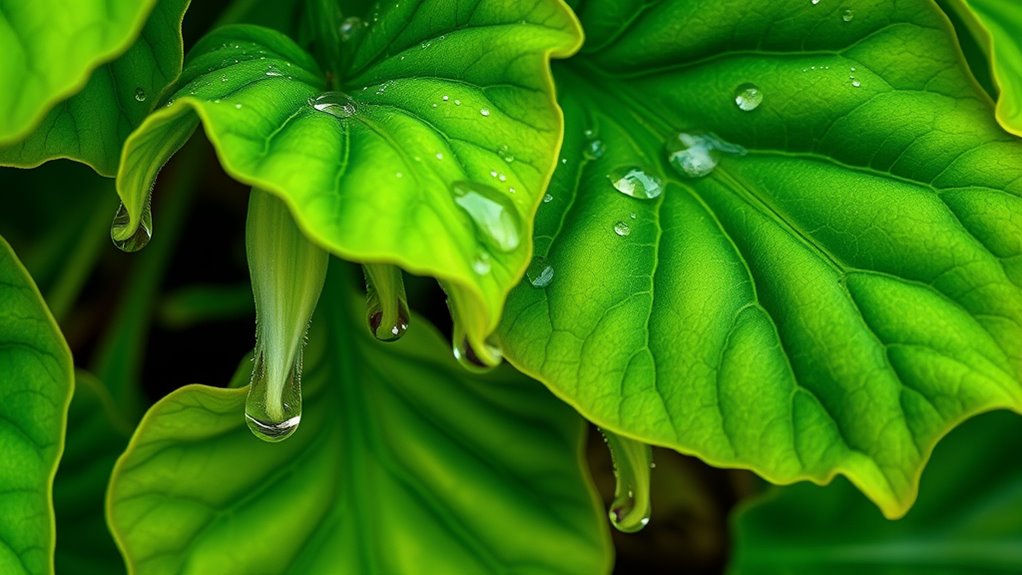
If your morning glory leaves remain droopy despite adjusting watering and sunlight, it’s a clear sign that you might need professional advice or additional support. Persistent drooping could indicate underlying issues like pest infestations or soil nutrient deficiency. You should seek help if you notice:
- Signs of pests such as discolored or chewed leaves
- Unexplained stunted growth or leaf deformities
- Soil that remains waterlogged or overly dry
- Yellowing or browning leaves indicating nutrient problems
- Recurrent disease symptoms despite treatment
Consulting a local horticulturist or gardening expert can help diagnose these issues accurately. They can recommend targeted treatments, soil amendments, or pest control strategies to restore your morning glory’s health and vitality.
Frequently Asked Questions
Can Morning Glory Leaves Droop Due to Pests or Diseases?
Yes, morning glory leaves can droop due to pests or diseases. Pest damage from insects like aphids or spider mites causes leaves to weaken, curl, or droop. Disease symptoms, such as fungal or bacterial infections, can also lead to leaf wilting and discoloration. If you notice drooping leaves, inspect your plant for pests or signs of disease to address the problem early and promote healthy growth.
How Does Soil Type Influence Leaf Turgidity?
Did you know that soil type affects 90% of plant health? When it comes to leaf turgidity, soil drainage is vital; poorly drained soil causes roots to suffocate, leading to drooping leaves. Nutrient availability also plays a big role, as rich soil helps maintain turgor pressure. Choosing well-draining soil with balanced nutrients guarantees your morning glory stays vibrant and turgid, preventing droopiness caused by water stress or deficiencies.
Do Different Morning Glory Varieties Have Varying Drooping Behaviors?
Different morning glory varieties do show variety-specific behavior in their drooping patterns. Cultivar differences influence how each type reacts to environmental factors, making some more prone to drooping during the day or after watering. You’ll notice that certain cultivars maintain turgidity longer, while others droop easily. Recognizing these differences helps you understand their unique needs and adapt your care accordingly, ensuring healthier plants and more vibrant blooms.
Is Leaf Drooping More Common in Potted or Garden-Grown Plants?
Like a gentle wave, leaf drooping can appear in both potted and garden-grown morning glories. You’re more likely to notice this in potted plants because they need frequent watering and have limited root space, which can affect root health. If you keep an eye on watering frequency, you can prevent stress and keep your plants vibrant. Proper watering helps roots stay healthy, reducing drooping regardless of where they’re planted.
Can Environmental Pollutants Affect Morning Glory Leaf Health?
Environmental pollutants can considerably impact your morning glory’s leaf health. Pollutant impact leads to leaf damage, causing discoloration, spots, or wilting. These pollutants, like ozone or sulfur dioxide, irritate the leaf tissues, weakening the plant and making it more susceptible to stress. To protect your plant, guarantee it’s in a clean environment or provide some shielding from pollutants, helping prevent further leaf damage and keeping your morning glory healthy.
Conclusion
By tuning into your morning glory’s whispers, you can tell if its leaves gently rest or if they’re crying out for help. With attentive watering and environment checks, you’ll nurture a vibrant, lively vine that dances in the sunlight. Think of your care as a soothing lullaby, guiding your plant through its daily rhythm. Trust your instincts, and your morning glory will flourish, a lush symphony of green in your garden’s melody.
